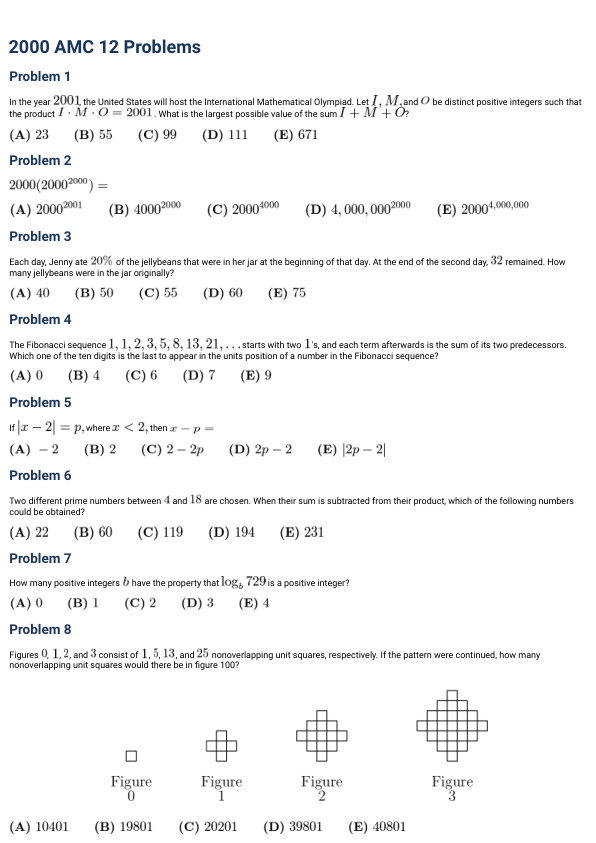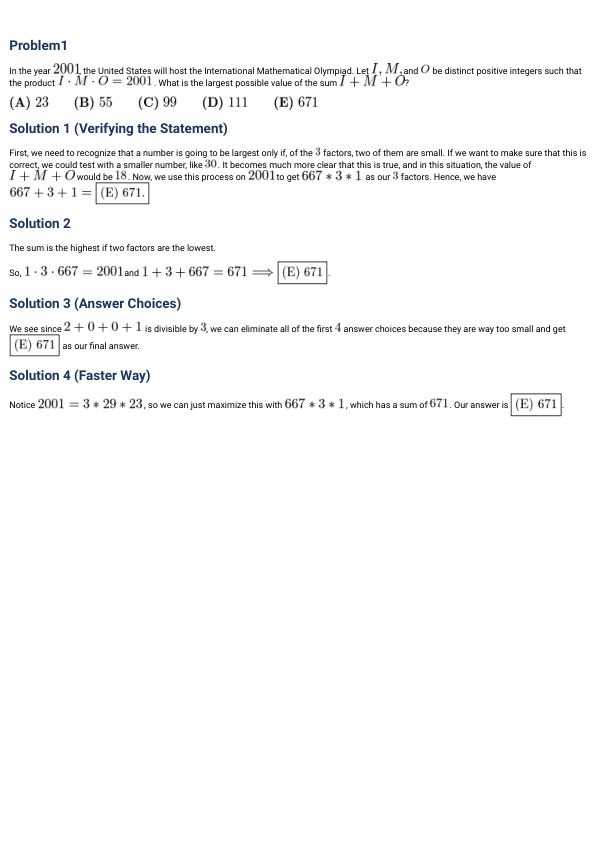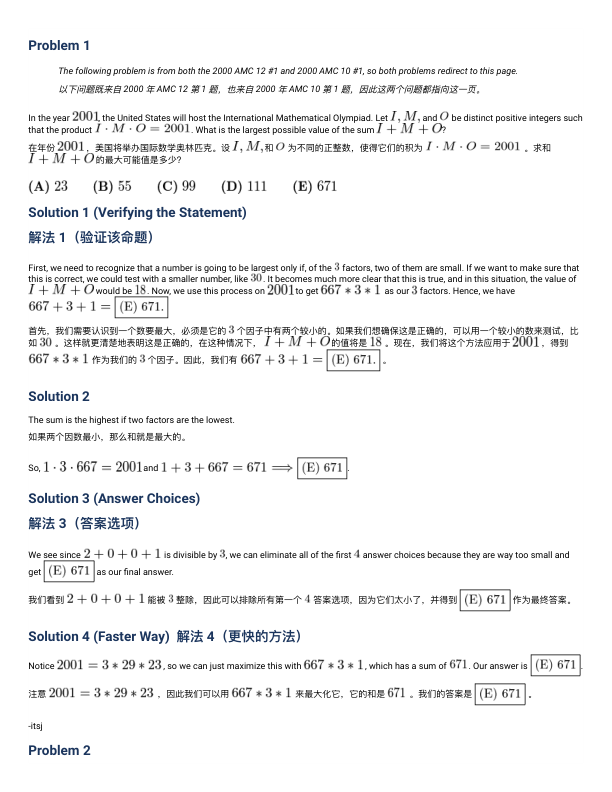2000 AMC amc12 真题 答案 详解
| 序号 | 文件列表 | 说明 | ||
|---|---|---|---|---|
| 1 | 2000-amc12-paper-eng.pdf | 4 页 | 214.03KB | 英文真题 |
| 2 | 2000-amc12-key.pdf | 1 页 | 9.93KB | 真题答案 |
| 3 | 2000-amc12-solution-eng.pdf | 36 页 | 1.29MB | 真题文字详解(英文) |
| 4 | 2000-amc12-solution-eng-zh.pdf | 36 页 | 1.47MB | 真题文字详解(中英双语) |
英文真题
2000 AMC 12 Problems
Problem 1
In the year 2001, the United States will host the International Mathematical Olympiad. Let I, M, and O be distinct positive integers such that the product I · M · O = 2001. What is the largest possible value of the sum I + M + O?
(A) 23 (B) 55 (C) 99 (D) 111 (E) 671
Problem 2
$2000(2000^{2000})=$
(A) $2000^{2001}$ (B) $4000^{2000}$ (C) $2000^{4000}$ (D) $4,000,000^{2000}$ (E) $2000^{4,000,000}$
Problem 3
Each day, Jenny ate 20% of the jellybeans that were in her jar at the beginning of that day. At the end of the second day, 32 remained. How many jellybeans were in the jar originally?
(A) 40 (B) 50 (C) 55 (D) 60 (E) 75
Problem 4
The Fibonacci sequence 1, 1, 2, 3, 5, 8, 13, 21, ... starts with two 1's, and each term afterwards is the sum of its two predecessors. Which one of the ten digits is the last to appear in the units position of a number in the Fibonacci sequence?
(A) 0 (B) 4 (C) 6 (D) 7 (E) 9
Problem 5
If |x - 2| = p, where x < 2, then x - p =
(A) -2 (B) 2 (C) 2 - 2p (D) 2p - 2 (E) |2p - 2|
Problem 6
Two different prime numbers between 4 and 18 are chosen. When their sum is subtracted from their product, which of the following numbers could be obtained?
(A) 22 (B) 60 (C) 119 (D) 194 (E) 231
Problem 7
How many positive integers b have the property that logb 729 is a positive integer?
(A) 0 (B) 1 (C) 2 (D) 3 (E) 4
Problem 8
Figures 0, 1, 2, and 3 consist of 1, 5, 13, and 25 nonoverlapping unit squares, respectively. If the pattern were continued, how many nonoverlapping unit squares would there be in figure 100?
(A) 10401 (B) 19801 (C) 20201 (D) 39801 (E) 40801

真题文字详解(英文)
Problem1 In the year 2001, the United States will host the International Mathematical Olympiad. Let ( I ), ( M ), and ( O ) be distinct positive integers such that the product ( I \cdot M \cdot O = 2001 ). What is the largest possible value of the sum ( I + M + O )?
[ \begin{array}{ll} (A) & 23 \ (B) & 55 \ (C) & 99 \ (D) & 111 \ (E) & 671 \ \end{array} ]
Solution 1 (Verifying the Statement)
First, we need to recognize that a number is going to be largest only if, of the 3 factors, two of them are small. If we want to make sure that this is correct, we could test with a smaller number, like 30. It becomes much more clear that this is true, and in this situation, the value of ( I + M + O ) would be 18. Now, we use this process on 2001 to get ( 667 * 3 * 1 ) as our 3 factors. Hence, we have ( 667 + 3 + 1 = \boxed{(E) 671} ).
Solution 2
The sum is the highest if two factors are the lowest.
So, ( 1 \cdot 3 \cdot 667 = 2001 ) and ( 1 + 3 + 667 = 671 \Rightarrow \boxed{(E) 671} ).
Solution 3 (Answer Choices)
We see since ( 2 + 0 + 0 + 1 ) is divisible by 3, we can eliminate all of the first 4 answer choices because they are way too small and get ( \boxed{(E) 671} ) as our final answer.
Solution 4 (Faster Way)
Notice ( 2001 = 3 * 29 * 23 ), so we can just maximize this with ( 667 * 3 * 1 ), which has a sum of 671. Our answer is ( \boxed{(E) 671} ).

真题文字详解(中英双语)
Problem 1 The following problem is from both the 2000 AMC 12 #1 and 2000 AMC 10 #1, so both problems redirect to this page. In the year 2001, the United States will host the International Mathematical Olympiad. Let I, M, and O be distinct positive integers such that the product I · M · O = 2001. What is the largest possible value of the sum I + M + O? (A) 23 (B) 55 (C) 99 (D) 111 (E) 671 Solution 1 (Verifying the Statement) 解法 1 (验证该命题) First, we need to recognize that a number is going to be largest only if, of the 3 factors, two of them are small. If we want to make sure that this is correct, we could test with a smaller number, like 30. It becomes much more clear that this is true, and in this situation, the value of I + M + O would be 18. Now, we use this process on 2001 to get 667 * 3 * 1 as our 3 factors. Hence, we have 667 + 3 + 1 = (E) 671. 首先,我们需要认识到一个数要最大,必须是它的三个因子中有两个较小的。如果我们想确保这是正确的,可以用一个较小的数来测试,比如 30。这样就更清楚地表明这是正确的,在这种情况下,I + M + O 的值将是 18。现在,我们将这个方法应用于 2001,得到 667 * 3 * 1 作为我们的三个因子。因此,我们有 667 + 3 + 1 = (E) 671. Solution 2 The sum is the highest if two factors are the lowest. 如果两个因数最小,那么和就是最大的。 So, 1 · 3 · 667 = 2001 and 1 + 3 + 667 = 671 → (E) 671 Solution 3 (Answer Choices) 解法 3 (答案选项) We see since 2 + 0 + 0 + 1 is divisible by 3, we can eliminate all of the first 4 answer choices because they are way too small and get (E) 671 as our final answer. 我们看到 2 + 0 + 0 + 1 能被 3 整除,因此可以排除所有前四个答案选项,因为它们太小了,并得到 (E) 671 作为最终答案。 Solution 4 (Faster Way) 解法 4 (更快的方法) Notice 2001 = 3 * 29 * 23, so we can just maximize this with 667 * 3 * 1, which has a sum of 671. Our answer is (E) 671. 注意 2001 = 3 * 29 * 23,因此我们可以用 667 * 3 * 1 来最大化它,它的和是 671。我们的答案是 (E) 671. -itsj Problem 2

